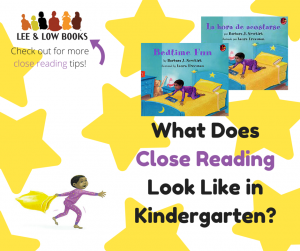Jaclyn DeForge, our Resident Literacy Expert, began her career teaching first and second grade in the South Bronx, and went on to become a literacy coach and earn her Masters of Science in Teaching. In her column she offers teaching and literacy tips for educators.
Over the next several weeks, I’ll be modeling how to do a close reading at several different grade levels. First up: Close Reading in Kindergarten using the D level text Bedtime Fun by Barbara J. Newkirk and illustrated by Laura Freeman.
In terms of student questioning, start general and move up Bloom’s Taxonomy by gradually increasing the rigor. For example, say you want to focus your close reading of Bedtime Fun on character development. Here are the questions I would ask:
Question 1 (Knowledge): Who is the main character in the story? Who is the story mostly about? Who are the other characters in the story? How do you know?
 Question 2 (Comprehension): What was the big thing that the entire story was about? How do you know?
Question 2 (Comprehension): What was the big thing that the entire story was about? How do you know?
Question 3 (Comprehension): Can you explain what is happening on page 3? On page 4? On page 6? How does the little boy change over the course of the story? What clues does the illustrator give us that show that the little boy is changing? How do you know?
Question 4 (Application): What would have happened if the little boy had tried to lie down and go to sleep after page 4? What makes you think that?
Question 5 (Analysis): Why do you think the little boy chose to play with his bear, jump on his bed, stand on his head, etc? What makes you think that? Make a connection to your own life or to another book you’ve read to support your answer.
Question 6 (Analysis): How would you describe the little boy? What is he like? How does he behave? How do you know?
Question 7 (Synthesis): Can you think of another thing the little boy could have done so he could stay up later?
Question 8 (Evaluation): What did you think of the little boy? Did you agree with the choices he made? Think about the author. Did you like the choices she made for the main character? Did you like the way the author ended the story? Why or why not?
Additional questions to ask:
- How does the main character remind you of yourself or of a character in another book you’ve read?
- Why do you think the author included Mama and Papa in the story?
- How do you think the little boy probably behaves when it’s time to get up and get ready for school? What makes you think that?
- What is important to the little boy? How do you know?
- What did the author do to make the little boy realistic?
 Even an 8 page book can serve as the foundation for some rigorous student discussions when read closely!
Even an 8 page book can serve as the foundation for some rigorous student discussions when read closely!
What are your favorite questions to ask when doing a close reading focused on character development?
Further reading on teaching literacy in Kindergarten:
- Building Classroom Community in Kindergarten
- How to Read with Your Rising Kinder This Summer
- How To Compare And Contrast With The Common Core In Kindergarten
- Integrating Reading, Writing, Speaking, & Listening In Grades K-1
Further reading on Close Reading series:
- What does close reading look like in First Grade?
- What does close reading look like in Second Grade?
- What does close reading look like in Third Grade?
- What does close reading look like in Fourth Grade?
- What does close reading look like in Fifth Grade?
- What is close reading?
- How to teach close reading using a RECIPE
- Close reading with book illustrations









